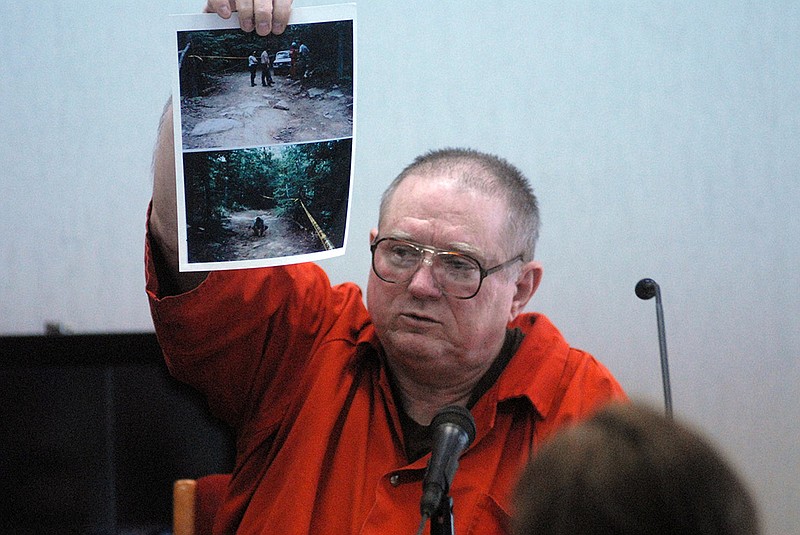Frank Casteel, the man convicted in the 1988 "Signal Mountain Murders," one of the most high-profile cases in recent memory in Hamilton County, has died in prison.
According to online state prison records, Casteel was listed as "deceased" Friday at 71 years old. His son, Trever, declined to comment further on the circumstances of his death, except to maintain his father's innocence and say "the story does not end." A Tennessee Department of Correction spokesman, Robert Reburn, could not be reached for further detail Friday.
In 1998, it took an hour and 45 minutes for a jury to find Casteel guilty on three counts of first-degree murder for the July 9, 1988, shotgun slayings of Ken Griffith, 22, of Red Bank; his father-in-law, Richard Mason, 49, of Signal Mountain; and Griffith's Air Force buddy, Earl Smock, 23, of Decatur, Tenn. The victims were last seen riding all-terrain vehicles toward The Blue Hole swimming spot at the edge of property Casteel had recently bought. In addition to prosecutors saying Casteel had angrily confronted dozens of people with a shotgun and noted in a logbook every time someone trespassed, the engineer was also placed camping with his wife in the area on the night in question.
Though Casteel was considered an immediate suspect, authorities didn't make an arrest until nearly a decade later. But the case itself took on a life of its own, perhaps, in part, because of the out-of-this-world details. It involved a mistress who began secretly recording Casteel in 1996 for authorities after she was warned that he was the killer, a wife who allegedly sent that anonymous warning, two attorneys who successfully co-prosecuted Casteel while running against each other for Hamilton County District Attorney, a second trial that once again resulted in Casteel's conviction, despite his son's insistence of innocence, and throughout it all, near-breathless media coverage.
"It was in the news for, it seemed like, 15 years," said Chattanooga attorney John Cavett, who represented Casteel at his second trial in 2003 after the Tennessee Court of Appeals sent the case back to Chattanooga on an evidentiary issue. "Lawyers and people were constantly contacting me saying, 'I know what really happened,' and most of the stories were a variation of a drug deal gone bad. Some had the additional flourish of people seeing planes flying over the mountain real low the day before. A number of people said they saw a parachute fall out of a plane. None of it panned out."
News archives show that search crews found the victims' decomposing bodies in what appeared to be a deer's bed off an old nearby logging road; mixed in with leaves was a pool of blood and brain tissue. In a different site, authorities found the ATVs, partly covered in human blood, dumped off a cliff. Prosecutors suspected Casteel, who had back problems, had help from his wife and other family members who were never charged.
Among witnesses who heard shotgun blasts that night was one who claimed to have seen Casteel's sons driving their Jeep with the bodies in tow. That son, Donnie, testified that he'd spent the night at his grandparent's house in Eastdale. Throughout the proceedings, Casteel's lawyers, Don Poole and Phil Lawrence, argued that police had blinders on, that someone else may have done it and that some witnesses had changed their statements about the previous encounters they'd had with Casteel.
Chattanooga attorney Lee Davis, then an assistant district attorney who'd recently prosecuted the first-ever case using mitochondrial DNA, said Hamilton County Sheriff's Office Detective Larry Sneed approached him about the triple slaying in late 1995 and asked if he would review the file for anything authorities might've missed. He began poring through multiple banker's boxes of notes and tracking down witnesses.
In the fall of 1996, authorities also learned that a woman named Marie Hill, a high-school sweetheart of Casteel's who had recently rekindled an affair with him, had received an anonymous letter claiming that Casteel was responsible for the murder, news archives show. Authorities tested that letter, Davis said, and it came back with Casteel's wife's DNA on it. The prosecution alerted Susie Casteel about that development, Davis said. And at trial, she ultimately testified that her husband had no involvement and said she'd sent the letter to scare Hill out of having the affair.
Hill, moreover, agreed to let deputies bug her home in 1996, and she began recording Frank Casteel. One interaction captured Casteel, his wife and Hill speaking for about three hours at Hill's home starting around 2:30 a.m. Casteel never denied or admitted to the slayings, but his wife spoke in veiled references about it, archives show.
Though the case was built on circumstantial evidence, Davis said he and then District Attorney General Bill Cox were able to leverage it successfully. By April 1997, Davis said he presented the case to a grand jury and secure an indictment against Frank Casteel for three counts of first-degree murder. The trial, which began the next spring, concluded after nine days, with Casteel earning a life sentence for each of the three killings.
Contact staff writer Zack Peterson at zpeterson@timesfreepress.com or 423-757-6347. Follow him on Twitter @zackpeterson918.

